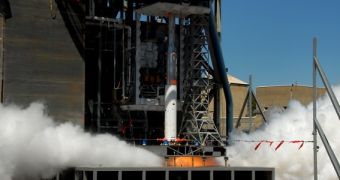Officials at NASA announced that a scale version of the Space Launch System (SLS) has again been tested acoustically at the agency's Marshall Space Flight Center (MSFC) in Huntsville, Alabama. When completed, this vehicle will boast the most powerful rocket engine in the world, and so engineers need to make sure that the delivery system can withstand the enormous pressure at launch.
The SLS itself will be the largest heavy-lift rocket developed in the United States, exceeding even the mighty Saturn V that took all Apollo missions to the Moon. At this point, it is scheduled to fly for the first time in late 2017 or early 2018 alongside the NASA Orion Multipurpose Crew Vehicle (MPCV), a new manned spacecraft under development with the space agency.
Acoustic testing is a significant milestone in the project to assemble the SLS. For the new round of assessments, MSFC engineers used a 5 percent scale model of the finished core stage on the rocket. The full-scale version of the component will be more than 60 meters (200 feet) tall and 8.5 meters (27.6 feet) across and will be fueled by a mixture of liquid hydrogen and liquid oxygen.
Powering up the core stage will be a series of RS-25 thrusters, which will be tasked with actually getting this massive rocket and its payload off the ground. The acoustic tests are meant to determine how the noise-reduction technologies available at launch pads today will handle the extreme noise produced by the SLS at takeoff, which could easily damage the rocket.

 14 DAY TRIAL //
14 DAY TRIAL //